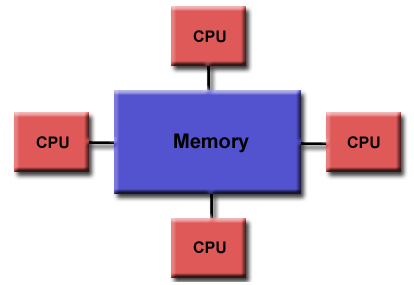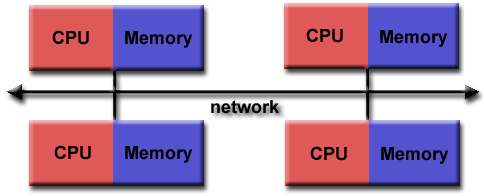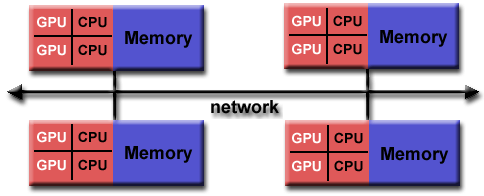Fundamentals of parallel programming¶
Parallel commputation can often be a bit more complex compared to standard serial applications. This page will explore these differences and describe how parallel programs work in general. We will also assess two parallel programming solutions that utilize the multiprocessor environment of a supercomputer.
Useful Links:
https://hpc.llnl.gov/documentation/tutorials/introduction-parallel-computing-tutorial##Whatis
Why Parallel?¶
Say you are attempting to assemble a 10,000-piece jigsaw puzzle* on a rainy weekend. The number of pieces is staggering, and instead of a weekend it takes you several weeks to finish the puzzle. Now assume you have a team of friends helping with the puzzle. It progresses much faster, and you are able to finish the puzzle within desired weekend. This principle is the central idea behind parallel computation. You can dramatically cut down on computation by splitting one large task into smaller tasks that multiple processors can perform all at once. With parallel processes a task that would normally take several weeks can potentially be reduced to several hours.
* Puzzle analogy for describing parallel computing adopted from Henry Neeman’s Supercomputing in Plain English tutorial series.
Serial and Parallel Processes¶
A serial process is simply a process that is run entirely by one core of one processor. This means tasks are run one after another as they appear in code. This is analogous to you doing the jigsaw puzzle on your own.
A parallel process is a process that is divided among multiple cores in a processor or set of processors. Each sub process can have its own set of memory as well as share memory with other processes. This is analogous to doing the puzzle with the help of friends. Because a supercomputer has a large network of nodes with many cores, we must implement parallelization strategies with our applications to fully utilize a supercomputing resource.
How parallel computation works¶
Parallel computation connects multiple processors to memory that is either pooled or connected via high speed networks. Here are three different types of parallel computation.
Shared Memory Model:
In a shared memory model all processors to have access to a pool of common memory that they can freely use.

(Image courtesy of LLNL https://computing.llnl.gov/tutorials/parallel_comp/ )
Distributed Memory Model:
In a distributed memory model a separate segment of memory is available to each processor. Because memory isn’t shared inherently, information that must be shared between processes is sent over a network.

(Image courtesy of LLNL https://hpc.llnl.gov/documentation/tutorials/introduction-parallel-computing-tutorial##MemoryArch)
Distributed/Shared Model:
A split distributed/shared model is a hybrid between a shared and distributed model and has the properties of both. Each separate set of processors sharing a set of common memory is called a node.

(Image courtesy of LLNL https://hpc.llnl.gov/documentation/tutorials/introduction-parallel-computing-tutorial##MemoryArch )
Alpine utilizes a hybrid distributed/shared model: there are 188 AMD Milan Compute nodes, 184 having 64 cores. 4 with 48 cores.
Tools for Parallel Programming¶
Two common solutions for creating parallel code are OpenMP and MPI. Both solutions are limited to the C++ or Fortran programming languages (though, other languages may be extended with C++ or Fortran code to utilize OpenMP or MPI).
OpenMP¶
OpenMP (“Open Multi-Processing”) is a compiler-side application programming interface (API) for creating code that can run on a system of threads. No external libraries are required in order to parallelize your code. OpenMP is often considered more user friendly with thread safe methods and parallel sections of code that can be set with simple scoping. OpenMP is, however, limited to the amount of threads available on a node – in other words, it follows a shared memory model. On a node with 64 CPUs, you can use no more than 64 processors.
MPI¶
MPI (“Message Passing Interface”) is a library standard for handling parallel processing. Unlike OpenMP, MPI has much more flexibility in how individual processes handle memory. MPI is also compatible with multi-node structures, allowing for very large, multi-node applications (i.e, distributed memory models). MPI is, however, often considered less accessable and more difficult to learn. Regardless, learning the library provides a user with the ability to maximize processing ability. MPI is a library standard, meaning there are several libraries based on MPI that you can use to develop parallel code. OpenMPI and Intel MPI are solutions available on most CURC systems.